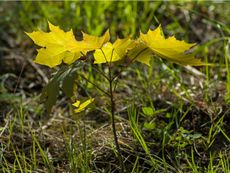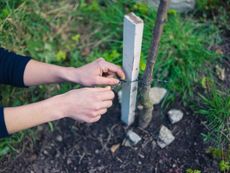Bareroot Planting: How To Plant Bareroot Trees


Many people buy bareroot trees and shrubs from mail order catalogs in order to take advantage of significant savings. But, when the plants arrive at their home, they may wonder how to plant bareroot trees and what steps do I need to take to ensure that my bareroot tree does well. Keep reading to learn more about planting bareroot trees.
After the Bareroot Tree Transplant Arrives
When your bareroot tree arrives, it will be in a dormant state. You can think of this as like suspended animation for plants. It's important to keep the bareroot plant in this state until you are ready to plant it in the ground; otherwise, the plant will die. In order to do this, make sure to keep the roots of the plants moist by leaving the wrapping on the roots or packing the roots in damp peat moss or soil. Once you are ready to start bareroot planting, mix together water and potting soil to a stew-like consistency. Remove the packing around the roots of the bareroot tree and place into the soil slurry for about an hour to help prepare the roots for planting into the ground.
How to Plant Bareroot Trees
Once you are ready to start the bareroot planting process, remove any tags, bags or wire that may still be on the tree. The next step in bareroot planting is to dig the hole. Dig the hole deep enough so that the tree will sit at the same level that it was grown at. If you look at the area on the trunk just above where the roots begin, you will find a darker colored “collar” on the bark of the trunk. This will mark the place that was ground level for the tree the last time the tree was in the ground and should be located just above the soil when you replant the tree. Dig the hole so that the roots can sit comfortably at this level. The next step when going about planting bareroot trees is to form a mound at the bottom of the hole where the roots of the tree can be placed over. Gently tease apart the bareroots of the tree and drape them over the mound. This will help the transplant develop a healthy root system that does not circle in on itself and become rootbound. The last step in how to plant bareroot trees is to backfill the hole, tamp the soil down around the roots to make sure there are no air pockets and water thouroughly. From here you can treat your bareroot tree like any other newly planted tree. Bareroot trees and shrubs area great way to purchase hard to find plants at great prices. As you have discovered, bareroot planting is not difficult at all; it just requires some prep ahead of time. Knowing how to plant bareroot trees can ensure that these trees will flourish in your garden for years to come.
Gardening tips, videos, info and more delivered right to your inbox!
Sign up for the Gardening Know How newsletter today and receive a free download of our most popular eBook "How to Grow Delicious Tomatoes."

Heather Rhoades founded Gardening Know How in 2007. She holds degrees from Cleveland State University and Northern Kentucky University. She is an avid gardener with a passion for community, and is a recipient of the Master Gardeners of Ohio Lifetime Achievement Award.
-
 Grow a Bathroom Oasis: 8 Best Bathroom Plants With No Light or Low Light
Grow a Bathroom Oasis: 8 Best Bathroom Plants With No Light or Low LightSome apartment dwellers grow the best bathroom plants with no light or low light. Read how one of our favorite plant lovers does it in the big city.
By Teo Spengler
-
 "My Worst Mistake" – Gardeners Share 10 Hard-Learned Lessons
"My Worst Mistake" – Gardeners Share 10 Hard-Learned LessonsGardeners never stop learning, and sometimes our mistakes are the best teachers. But why not save time and heartache by learning from other gardeners' failures?
By Melanie Griffiths
-
 Best Trees For Carbon Sequestration And Climate Change
Best Trees For Carbon Sequestration And Climate ChangeLet’s keep planting trees. They are our best bet for capturing carbon and may help with our global warming issues.
By Teo Spengler
-
 6 Invasive Trees You Should Never Plant In Your Yard
6 Invasive Trees You Should Never Plant In Your YardWhat are some invasive trees you should never plant in your yard? Click here to find out.
By Teo Spengler
-
 How Close Can You Plant A Tree To A Stump?
How Close Can You Plant A Tree To A Stump?Looking to plant new trees near old stumps or where stumps have been removed? Click here to learn how.
By Teo Spengler
-
 Messiest Trees That Drop Debris Everywhere
Messiest Trees That Drop Debris EverywhereWant to know which trees will create the biggest messes in your home landscape? Click here to find out.
By Amy Grant
-
 How To Get Rid Of Tree Sprouts In The Yard From Nearby Trees
How To Get Rid Of Tree Sprouts In The Yard From Nearby TreesLearn the simple way to keep pesky tree seedlings in your lawn from becoming saplings.
By Teo Spengler
-
 7 Common Tree Care Mistakes That Kill Trees
7 Common Tree Care Mistakes That Kill TreesAre you accidentally killing your tree? It's easier than you think, if you're committing one of these common mistakes. Click here for more.
By Teo Spengler
-
 How To Tell How Old A Tree Is
How To Tell How Old A Tree IsEver wondered how to calculate the age of a tree? Click here to learn all about it.
By Teo Spengler
-
 When To Remove Tree Stakes From Saplings
When To Remove Tree Stakes From SaplingsA newly planted tree may grow strong when it’s staked, but don’t forget to remove the stakes when it’s stable.
By Teo Spengler